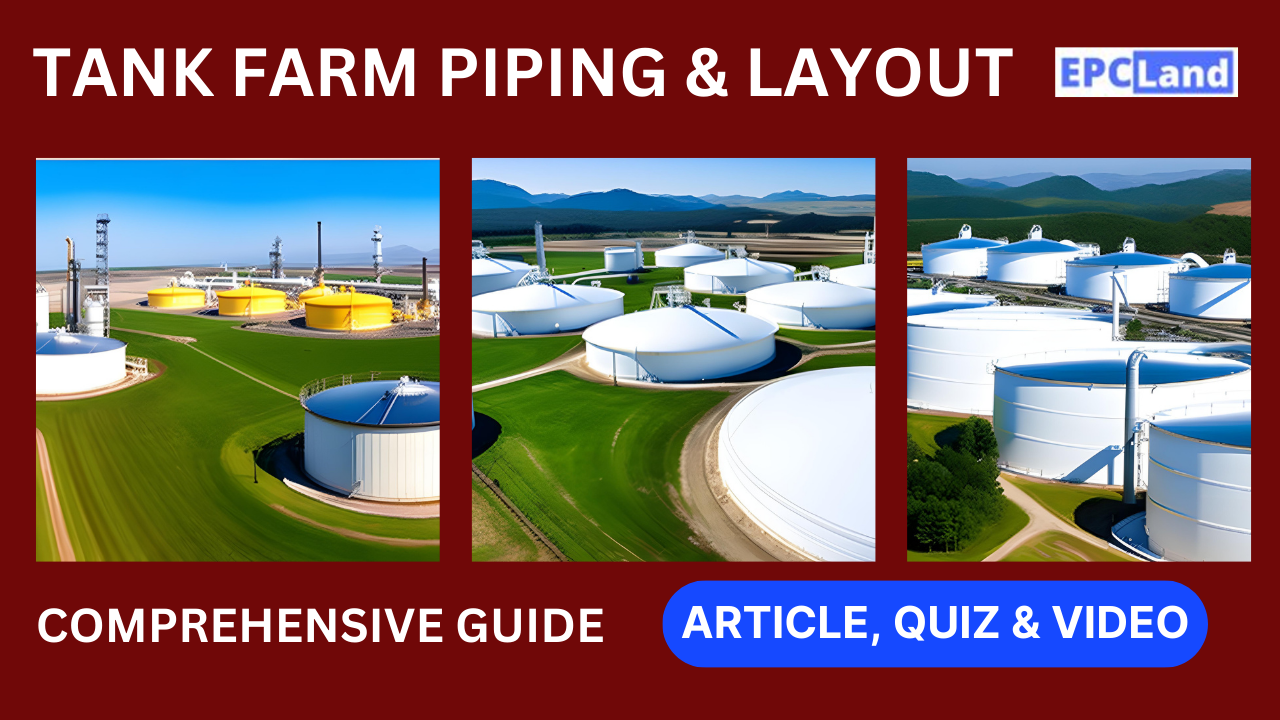Introduction
A. Importance of Tank Farms in Oil & Gas Industry
In the oil and gas sector, tank farms play a pivotal role in the storage, handling, and distribution of various petroleum products, including crude oil, refined products, chemicals, and liquefied gases. These tank farms serve as essential infrastructure nodes within the supply chain, bridging the gap between production facilities and end-users. Tank farms provide a buffer for fluctuating demand, enabling a steady flow of products to meet market needs. Given the industry’s reliance on reliable storage and distribution, the design and layout of tank farms have a direct impact on operational efficiency, safety, and environmental considerations.
Table of Contents
B. Role of Tank Farm Layout and Piping Design
The layout of a tank farm and its piping design are critical aspects that determine the facility’s functionality, safety, and effectiveness. The arrangement of tanks, equipment, and piping networks should be meticulously planned to ensure smooth product movement, minimize operational risks, and adhere to regulatory requirements. Additionally, a well-designed tank farm layout takes into account factors such as safety distances between tanks, fire protection measures, accessibility for maintenance, and emergency response preparedness.
The piping design within a tank farm involves the intricate network of pipes that connect various tanks, pumps, valves, and loading/unloading facilities. Proper pipe sizing, material selection, and integration of control systems are crucial for maintaining efficient product flow, preventing leaks, and ensuring accurate inventory management. A well-structured piping system contributes to the overall reliability and safety of the tank farm operations.
Do not miss the detailed course on Tank Farm Piping & Layout and Stress Analysis
Enrollment Link
II. Tank Farm Layout Considerations
A. Site Selection and Land Use
1. Proximity to Refineries and Distribution Centers
Selecting an optimal site for a tank farm involves strategic considerations related to proximity. The location should be strategically chosen to minimize transportation costs and optimize supply chain efficiency. A site close to refineries and distribution centers ensures a steady supply of products, reducing transportation-related bottlenecks and costs.
2. Environmental Regulations and Safety Measures
Environmental regulations play a vital role in site selection. The chosen location must adhere to zoning laws, land-use regulations, and environmental impact assessments. Safety measures such as keeping an appropriate distance from populated areas, water bodies, and other high-risk facilities are essential to mitigate potential hazards.
B. Spacing and Arrangement of Tanks
1. Minimum Safe Distances between Tanks
To prevent catastrophic incidents, minimum safe distances between tanks are crucial. These distances account for factors such as fire protection, potential leakage, and emergency response access. Proper spacing not only ensures operational safety but also aids in maintenance and inspections.
2. Layout Optimization for Accessibility and Operation
An efficiently designed layout facilitates easy access for personnel, vehicles, and equipment. Optimized pathways between tanks, loading/unloading points, and maintenance areas enhance operational efficiency. Consideration must be given to vehicle maneuverability, avoiding congestion, and accommodating potential expansion.
C. Fire Protection and Safety Measures
1. Fire Suppression Systems Placement
Strategically positioning fire suppression systems, such as fire hydrants, foam monitors, and firewater storage tanks, is essential to combat potential fire hazards. Adequate coverage ensures rapid response in case of emergencies, safeguarding both personnel and infrastructure.
2. Emergency Response Planning
Emergency response planning should be integrated into the layout design. Evacuation routes, assembly points, and emergency equipment locations should be clearly marked. Effective planning enables swift response and minimizes the impact of any unforeseen incidents.
D. Equipment Placement and Accessibility
1. Pumps, Valves, and Loading/Unloading Facilities
The placement of pumps, valves, and loading/unloading facilities directly influences the efficiency of product transfer. Proper positioning reduces piping complexity, minimizes pressure losses, and optimizes flow rates. Additionally, ensuring adequate space for equipment maintenance and repair is crucial.
2. Maintenance and Inspection Accessibility
Facilitating routine maintenance and inspection activities is imperative for sustained operational performance. Designing walkways, platforms, and access points near tanks and equipment simplifies maintenance tasks, improves safety during inspections, and supports compliance with industry regulations.
The thoughtful consideration of these tank farm layout aspects lays the foundation for a functional, safe, and efficient facility. By strategically addressing site selection, spacing, safety measures, and equipment placement, operators can enhance operational reliability and mitigate potential risks.
Do not miss the detailed course on Tank Farm Piping & Layout and Stress Analysis
Enrollment Link
III. Tank Farm Piping Design
A. Piping Network Design
1. Inlet and Outlet Piping for Tanks
Designing inlet and outlet piping for tanks requires careful consideration of flow rates, pressure drop, and product characteristics. Proper sizing and routing of these pipes ensure efficient loading and unloading processes, minimizing waiting times and optimizing throughput.
2. Interconnecting Piping between Tanks
Interconnecting piping forms a network that facilitates the transfer of products between tanks. This network should be designed to minimize cross-contamination risks and ensure smooth product flow. Correct pipe sizing, valve placement, and routing contribute to efficient inter-tank transfers.
B. Pipe Sizing and Material Selection
1. Fluid Flow Considerations
Pipe sizing plays a pivotal role in maintaining desired flow rates and pressure levels. Calculating pipe diameters based on fluid properties, distance, and expected flow rates ensures optimal performance. Proper pipe sizing prevents issues such as excessive pressure drop and flow restrictions.
2. Corrosion Resistance and Material Compatibility
Selecting appropriate pipe materials is essential for longevity and reliability. Considerations include the corrosive nature of the transported fluids, compatibility with the tank contents, and environmental conditions. Choosing corrosion-resistant materials enhances the lifespan of the piping system and minimizes maintenance requirements.
C. Pump and Valve Integration
1. Pump Selection and Placement
Pump selection should align with flow requirements and pressure specifications. Proper pump placement, along with considerations for pump type (centrifugal, positive displacement, etc.), contributes to efficient product movement. Pumps should be strategically located to minimize suction head and pressure losses.
2. Valve Types and Placement for Flow Control
Valves play a crucial role in regulating flow, isolating sections of the system, and facilitating maintenance. Selecting appropriate valve types (gate, globe, ball, etc.) based on their function enhances flow control. Proper valve placement allows for effective isolation during maintenance activities.
D. Overfill Protection and Leak Detection
1. Automated Monitoring Systems
To prevent overfills and leaks, automated monitoring systems are indispensable. Level sensors, pressure transmitters, and other monitoring devices continuously track tank levels and system pressures. These systems trigger alarms or shut off valves when abnormal conditions are detected.
2. Emergency Shutdown Systems
Emergency shutdown systems are designed to rapidly halt operations in case of critical issues. These systems are interconnected with sensors, alarms, and valves to ensure swift response to potential hazards, preventing accidents and minimizing environmental impact.
By meticulously addressing the design of the piping network, including inlet/outlet pipes, interconnecting pipes, sizing, material selection, and integration of pumps and valves, tank farm operators can establish a reliable and efficient system for transferring products within the facility. Incorporating overfill protection and leak detection mechanisms further enhances operational safety and environmental responsibility.
Do not miss the detailed course on Tank Farm Piping & Layout and Stress Analysis
Enrollment Link
IV. Environmental and Regulatory Considerations
A. Environmental Impact Assessment
1. Containment and Spill Prevention
Tank farms must implement measures to contain spills and prevent environmental contamination. Secondary containment systems, such as bund walls and dikes, help contain spills and prevent them from spreading to surrounding areas or water bodies.
2. Groundwater Protection Measures
Protecting groundwater from potential leaks is critical. Impermeable liners, leak detection systems, and regular monitoring ensure that any leaks are promptly detected and addressed, preventing groundwater pollution.
B. Regulatory Compliance
1. Local, State, and Federal Regulations
Tank farms are subject to various regulations at the local, state, and federal levels. These regulations cover aspects such as site selection, safety measures, environmental protection, and emergency response planning. Compliance is essential to avoid legal and operational challenges.
2. Compliance with Industry Standards (API, NFPA, etc.)
Industry standards set by organizations like the American Petroleum Institute (API) and the National Fire Protection Association (NFPA) provide guidelines for tank farm design, construction, and operation. Adhering to these standards ensures best practices are followed, enhancing safety and operational efficiency.
Adhering to environmental and regulatory considerations is crucial for maintaining sustainable and responsible tank farm operations. By implementing measures to prevent spills, protect groundwater, and comply with relevant regulations and standards, tank farm operators can contribute to environmental conservation and maintain legal compliance.
V. Automation and Control Systems
A. SCADA Systems (Supervisory Control and Data Acquisition)
1. Remote Monitoring and Control
SCADA systems enable remote monitoring and control of tank farm operations. Through a centralized interface, operators can monitor tank levels, flow rates, pressures, and other critical parameters in real-time. This remote capability improves operational efficiency and response times.
2. Real-time Data Visualization
SCADA systems provide real-time data visualization, offering operators insights into the status of various tanks and equipment. Trend analysis, historical data comparison, and predictive analytics empower operators to make informed decisions for optimizing operations.
B. Tank Gauging and Inventory Management
1. Level Measurement and Monitoring
Accurate tank level measurement is essential for inventory management. Tank gauging systems utilize technologies like radar, ultrasonic, or hydrostatic sensors to provide precise level readings. Real-time level monitoring helps prevent overfills and shortages.
2. Inventory Optimization and Demand Forecasting
Tank farms can optimize inventory levels based on demand forecasts and historical consumption patterns. Automated systems assist in maintaining optimal stock levels, reducing storage costs, and ensuring timely deliveries to customers.
Incorporating advanced automation and control systems significantly enhances the efficiency, safety, and reliability of tank farm operations. SCADA systems enable remote oversight and real-time data analysis, while tank gauging and inventory management systems contribute to accurate stock tracking and improved resource allocation.
Do not miss the detailed course on Tank Farm Piping & Layout and Stress Analysis
Enrollment Link
VI. Case Studies
A. Tank Farm Layout Case Study
1. Challenges Faced and Solutions Implemented
In this case study, we explore a tank farm facing challenges related to inadequate spacing between tanks, leading to safety concerns and operational inefficiencies. The solution involved reorganizing the tank layout to meet safety standards, minimize risk of cross-contamination, and improve emergency response access.
2. Successful Design Impact on Operations
By implementing the redesigned tank farm layout, the facility experienced enhanced safety protocols and improved operational flow. The reconfigured layout allowed for optimized maintenance access and increased throughput, resulting in improved efficiency and reduced downtime.
B. Piping Design Case Study
1. Complex Piping Network Design and Management
This case study examines a tank farm with a complex interconnecting piping network that led to flow disruptions and maintenance challenges. The solution included re-evaluating pipe sizing, implementing better valve control, and integrating a digital monitoring system.
2. Enhanced Safety and Efficiency Achieved
Following the implementation of the new piping design, the tank farm experienced improved flow control, reduced pressure losses, and minimized operational disruptions. The integrated monitoring system enabled real-time detection of leaks and abnormalities, further enhancing safety measures.
These case studies highlight real-world scenarios where effective tank farm layout and piping design significantly impacted operational efficiency, safety, and overall performance. Through strategic redesign and integration of advanced technologies, operators were able to overcome challenges and achieve positive outcomes.
VII. Future Trends in Tank Farm Design
A. Digitalization and IoT Integration
Tank farms are increasingly adopting digital technologies and the Internet of Things (IoT) to enhance operations. IoT sensors provide real-time data on tank conditions, equipment health, and environmental parameters. This integration enables predictive maintenance, optimized inventory management, and improved decision-making.
B. Sustainability and Energy Efficiency Measures
As sustainability becomes a priority, tank farms are exploring energy-efficient solutions. Renewable energy sources, advanced insulation materials, and optimized heating and cooling systems contribute to reduced energy consumption and carbon footprint. Additionally, water recycling and waste reduction initiatives align with environmental sustainability goals.
C. Advances in Leak Detection and Containment Technologies
Incorporating cutting-edge technologies like acoustic sensors, fiber-optic monitoring, and advanced imaging, tank farms are enhancing leak detection capabilities. These innovations enable swift identification and containment of leaks, minimizing potential environmental damage and operational disruptions.
The future of tank farm design will be shaped by these trends, with increased reliance on digitalization, a commitment to sustainability, and the adoption of advanced technologies that prioritize safety and environmental responsibility.
Do not miss the detailed course on Tank Farm Piping & Layout and Stress Analysis
Enrollment Link
VIII. Conclusion
A. Importance of Effective Tank Farm Layout and Piping Design
Effective tank farm layout and piping design are pivotal in ensuring the safe, efficient, and environmentally responsible operation of oil and gas facilities. Properly designed layouts optimize space, facilitate access for maintenance and emergency response, and minimize operational risks.
B. Integration of Safety, Efficiency, and Environmental Concerns
Balancing safety, operational efficiency, and environmental considerations is key. A well-designed tank farm minimizes the risk of accidents, ensures regulatory compliance, and reduces the impact on the environment.
C. Continuous Evolution of Design Practices in the Oil & Gas Sector
The oil and gas industry is continually evolving, driven by advancements in technology, regulatory changes, and sustainability goals. Tank farm design practices will continue to adapt to these shifts, incorporating new tools and methodologies to meet the industry’s changing demands.
In conclusion, tank farm layout and piping design are critical components of oil and gas operations, directly impacting safety, efficiency, and environmental stewardship. By staying informed about industry best practices and embracing technological advancements, professionals can ensure that tank farms remain integral to the reliable supply of energy resources in the years to come.
FAQs
1. Why is Tank Farm Layout Important in the Oil & Gas Industry?
Effective tank farm layout ensures safe storage, efficient product movement, and compliance with regulations. It minimizes risks, optimizes space, and supports emergency response preparedness.
2. How Does Piping Design Impact Tank Farm Operations?
Piping design influences the seamless transfer of products between tanks and facilities. Proper pipe sizing, material selection, and valve placement are crucial for maintaining flow rates and preventing leaks.
3. What Environmental Considerations Should Tank Farms Address?
Tank farms must implement spill prevention measures, groundwater protection, and adhere to environmental regulations. Proper containment, leak detection systems, and compliance with standards contribute to responsible operations.
4. How Does Automation Enhance Tank Farm Efficiency?
Automation systems like SCADA enable remote monitoring, real-time data analysis, and inventory management. These technologies improve operational efficiency, reduce downtime, and enhance decision-making.
5. How is Sustainability Being Integrated into Tank Farm Design?
Sustainability measures include adopting renewable energy sources, using efficient insulation, and implementing water recycling initiatives. Tank farms are increasingly focusing on reducing energy consumption and minimizing their environmental footprint.
Recommended courses (Published on EPCLand)
- Basics of Piping Engineering
- Piping Layout Engineering
- Piping Material Engineering
- Piping Stress Analysis
- Complete Course on Piping Engineering
- Material Requisitions
- Piping Material Specifications
- Valve Material Specifications
Don’t miss the published articles on following:
Related Video
Attempt Quiz
Question 1:
What is the primary purpose of tank farm piping in the oil and gas sector?
Explanation: The primary purpose of tank farm piping in the oil and gas sector is to store and distribute various petroleum products, such as crude oil, refined products, and chemicals, within a storage facility.
Question 2:
What type of pipes are commonly used in tank farm piping systems?
Explanation: Stainless steel pipes are commonly used in tank farm piping systems due to their durability, corrosion resistance, and ability to handle various petroleum products.
Question 3:
What is the significance of pipe supports in tank farm piping?
Explanation: Pipe supports are essential in tank farm piping to provide proper alignment, prevent excessive stress, and accommodate thermal expansion and contraction, ensuring the integrity and stability of the piping system.
Question 4:
Which regulatory standards are often followed when designing tank farm piping systems?
Explanation: Industry standards such as API 650 (for above-ground storage tanks) and API 653 (for tank inspection, repair, alteration, and reconstruction) are often followed when designing tank farm piping systems to ensure safety, reliability, and compliance.
Question 5:
What are some of the challenges associated with tank farm piping design?
Explanation: Tank farm piping design faces challenges such as ensuring compatibility with surrounding infrastructure and equipment, addressing environmental regulations, and optimizing space utilization while maintaining safe and efficient operations.



